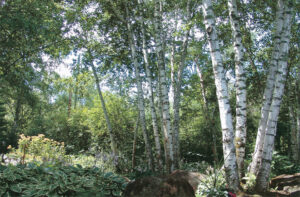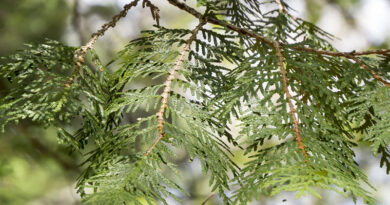Cleaning Up the Earth with Trees
 It is well known now that trees clean the air, removing carbon dioxide and converting it to oxygen in the process of photosynthesis. Along the way, leaves remove some airborne ammonia, sulphur dioxide, nitrogen oxides and ozone. But it is only more recently that trees – and other plants – have been winning respect for their ability to clean up polluted soil and ground water.
It is well known now that trees clean the air, removing carbon dioxide and converting it to oxygen in the process of photosynthesis. Along the way, leaves remove some airborne ammonia, sulphur dioxide, nitrogen oxides and ozone. But it is only more recently that trees – and other plants – have been winning respect for their ability to clean up polluted soil and ground water.
In a process called phytoremediation, plants clean up ground contamination using three different processes.
Phytoextraction is where the contaminants are lifted hydraulically and moved upward through the tree’s hydraulic system. Some of the contaminants may be stored in its trunk or leaves and the balance transpired through leaf stomata back into the atmosphere in lower concentrations.
Phytodegradation is the breakdown or metabolism of contaminants through complex interactions between tree roots and the bacteria and other life forms that surround them. The third is phytostablization, which fixes the pollutant in place and reduces its movement or availability.
It was only in the 1980s that it was discovered that some plants have a tolerance for heavy metals in levels that would generally be considered highly toxic. Since then phytoremediation has been tested at over 200 sites in the United States alone. The system is now being actively used in many places around the world to deal with ground pollution.
At a contaminated site near Forth Worth, Texas, poplars were planted above shallow ground water contaminated with low levels of trichloroethene (TCE). They were then observed over a number of years and the water and trees were tested. Within the first three years, there was a noticeable reduction in the contamination thanks to these very young trees, which were dealing with some
of the TCE through the process of phytoextraction and transpiration. Most interesting were the additional changes that took place underground in the environment created by the trees’ root systems.
What researchers found is that after two years, the roots’ environment had changed both biologically and geologically. There were more bacteria. There was less oxygen. As this occurred, anaerobic bacteria and methanogenic micro-organisms appeared.
These tiny, single-celled life forms don’t use oxygen and complex carbon compounds for energy, but instead rely on simple organic compounds such as acetate, and instead of oxygen use hydrogen, producing carbon dioxide or methane as a by-product. As a result of these changes and the appearance of these life forms, the contaminant was also changed. It was disappearing more and more rapidly, leading to the conclusion that both transpiration and biodegradation were being
utilized by the growth of the tree to reduce the contamination.
At this point, phytoremediation has been used to clean up metals, pesticides, solvents, explosives, crude oil and hydro-carbons. Hybrid poplars, aspen, cottonwoods and willows seem to be the most commonly used trees because they grow quickly, have a large leaf canopy and use lots of water. But it isn’t only trees that are used, although their roots go deeper and are therefore the best at reaching deeper underground; other herbaceous plants have been tested with similar good results and are being used to cap landfill sites to assist in the degradation of contaminants
In the phytostabilization process, a Chinese brake fern is being used to remove arsenic from a site in Spain. This fern thrives on arsenic, which is taken up and stored in high concentrations in the tips of the fronds. (It should be mentioned that trees, too, store some of the compounds they remove, mainly in their trunks but also sometimes in their leaves and at other times in or on their roots.) At the Ford Motor Company in Dearborn, Michigan, steelmaking left a site contaminated with carcinogenic compounds which are being cleaned up by native plants. The star cleaners included Joe Pye weed and New England aster.
In Slovenia, it is poplar trees once again that are being used to cap a landfill to prevent the leaching of landfill contamination into the ground water. In Maryland, toxic pits, contaminated with chemical warfare agents from the ’40s to the ’70s, are being cleaned by a poplar plantation. In 1996, 183 poplars per acre were planted to do the job there and the U.S. defence department estimates it will take only 30 years to remove 85 per cent of the waste.
Phytoremediation takes time and the practice raises unanswered questions, some of them that extend almost into the realm of science fiction. One such is whether there are opportunities for manufacturing pharmaceuticals using plants. Other questions, such as what to do with a plant that is storing heavy concentrations of metals and other compounds, are more practical and urgent.
(Can the products be recovered? Should they be? Will dying materials recontaminate the site?) These are all good questions, but the prevailing school of thought seems to be that phytoremediation is a sensible and low cost alternative to the mechanical methods also employed.
This is just one more reminder of how important the green world is in keeping our world a safer, cleaner place. And that’s a good thing.




